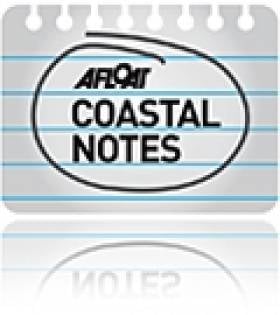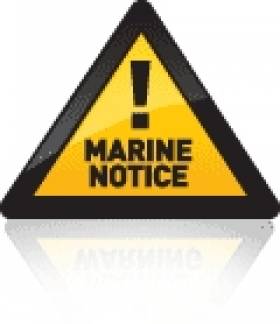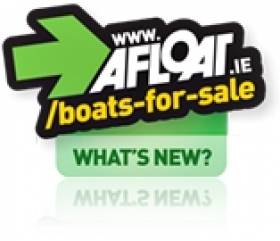Displaying items by tag: boat
Castleconnell Boat Club Reacts to Shannon Incident
Castleconnell Boat Club has released a statement regarding the capsize on the Shannon:
Early this morning (Thursday 4th February) Castleconnell Boat Club was informed that a number of individuals had entered the club grounds at World’s End at approximately 4am. The club was only recently accessible after weeks of total flooding, and much of the surrounding area had been under water, or damaged. Four men removed one of the club safety launches, which was without an engine, and put it on the water.
With flooding still an issue the water was very high, and the water extremely fast. We have been told that the men got into difficulty very quickly, and we believe they capsized nearby. Early news reports say that that emergency services spent several hours rescuing them and that they are being treated in Limerick Hospital.
Safety is always the top of CCBC agenda and the thoughts of anyone on such dangerous water especially at that time of night, and without means to propel the boat is frightening in the extreme. No members have been permitted on the water for over two months, due to safety concerns.
The dangers of water cannot be over emphasised and we commend the bravery and the professionalism of the Coast Guard, and the Emergency Services.
Our thoughts and best wishes are with the individuals and their families at this terrible time.
Yours in rowing,
Francis Moloney
Club President CCBC
Ireland's Invisible Boat Builders
#boatbuilders – In the good old days of bespoke boat-building, regular visits to the boatyard by the prospective owners were a sociable part of the process, regarded as normal and mutually instructive. And as most boats were built in waterfront premises beside slipways, or at the very least on a quayside, the first immersion was much more than just an informal splash from a convenient travel-hoist or a crane. On the contrary, it was the Launching Ceremony, a carefully choreographed festive event complete with the breaking of a bottle and sometimes even including the proper blessing of the new boat.
But nowadays, while such events can to some extent be staged, inevitably they have a certain artificiality. With transportation vehicles and roads improved out of all recognition, most production boats are now being built in factories at some distance from the sea - waterfront property is much too valuable to be used for basic industrial purposes.
As for seeing "your" boat being factory-built, you have to be up towards the top of the product range to be allowed that, and even then you mustn't bother the builders by talking to them. So the "launching" is simply a practical task carried out by professional marina staff with a minimum of fuss, for it has always been the case that when you just want to get on with a launching in a businesslike way, the last person you need around the place is the fretful owner.
Thus today's marine industry aspires to be the waterfront version of the car trade. Smooth, clean and impressive premises. Ready-to-go immaculate vehicles. And no hint at all of the need to get deep down and dirty in the building and maintenance of boats. But not every sailing and boat enthusiast is content with accepting such production-line techniques. W M Nixon takes a look at some of Ireland's invisible boat builders who cater for those owners who are different, and sometimes are doing it entirely for themselves. He also reveals the revolutionary Clontarf Contrivance, a Boon for Boatbuilders in classic style.
There are two Gods in the pantheon of Ireland's invisible boat-builders. One is Jimmy Furey, who creates exquisite classic clinker-built beauties to order in his tiny workshop in County Roscommon near the west shore of Lough Ree. And the other is Roy Dickson, who is incapable of sailing any boat without thinking of some way he'd like to improve it, and was a pioneer of the DIY dinghy-building movement in Ireland a very long time ago.
They're the Gods of our pantheon as both are now well into their eighties, and their influence has spread far beyond the shores of Ireland despite the fact that both are unassuming men who like nothing better than quietly getting on with the job.
But while Jimmy Furey is part of a long and distinguished Shannon tradition in that his innate talents emerged from working with his boat-builder brother Paddy, and are in turn being passed on to other master craftsmen such as Dougal MacMahon of Belmont on the western stretches of the Grand Canal, Roy Dickson is a complete one-off who is an inspiration to many, but you couldn't really say that there is a Roy Dickson School of Boat Re-Configuration.
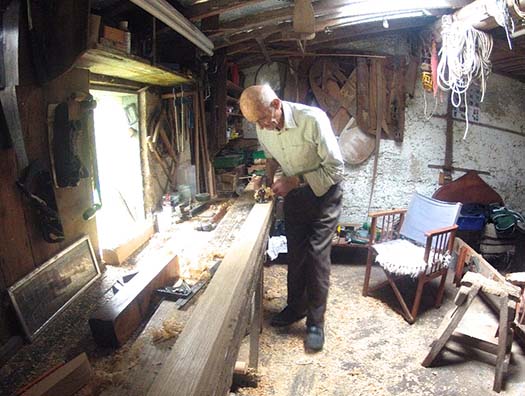
Jimmy Furey quietly in action in his remote workshop in County Roscommon on the west shore of Lough Ree. Photo: Cathy McAleavey
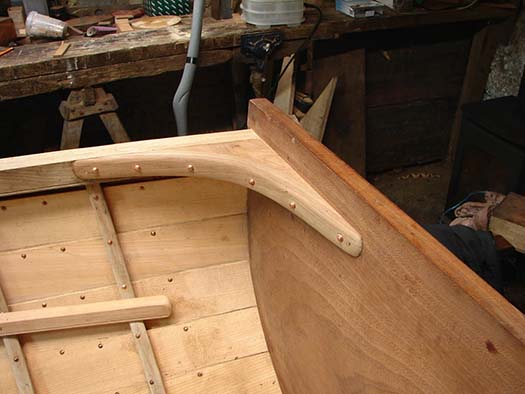
The detail is a joy to behold. One of the transom knees in a Jimmy Furey Water Wag. Photo: Cathy McAleavey
The joy of Jimmy Furey's work is in the detail, so it's no surprise to learn that he turns his hand from time to time to being an award-winning model maker. But the beauty of his boats, whether they be Shannon One Designs or Water Wags, is of such a high order that you could say they're of international classic model boat standard while happening to be full size boats which can give a good account of themselves on the race course.
There is only so much work that any one man, however talented, can do, so it's encouraging to know that Dougal MacMahon is following the Furey way, his most recent job being restoration work with new planks and gunwhale, and re-installation of the centreplate casing, in Ian & Judith Malcolm's hundred-year-old Dublin Bay Water Wag in order for the boat to be fit to take part in next month's massive migration of the Wags to the big Morbihan festival in south Brittany. There, they will link up for the first time with the new French-built Water Wag, the product of Skol ar Mor which has been bought by Adam Winkelmann of Dun Laoghaire.
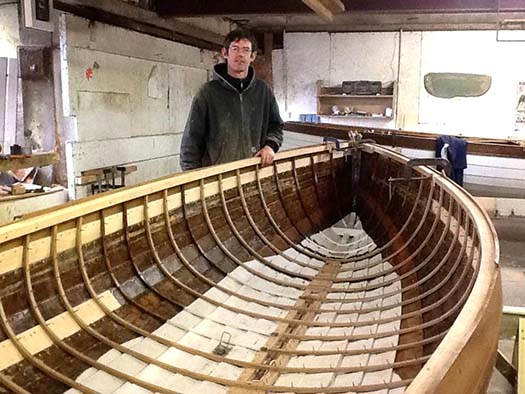
Dougal MacMahon of Belmont in County Offaly at the midway stage of this month's project to put a hundred-year-old Water Wag back into full health. Photo: Ian Malcolm
Having been looking at the new work on the Malcolms' Centenarian Barbara yesterday morning, rest assured that the Levinge/Furey style and quality is being upheld by Dougal MacMahon. Any good clinker-built racing boat will have a certain suppleness – indeed, it's said that one of the skinny Shannon One Designs will turn round and look at you when being driven to the utmost in a hard breeze. But with the Barbara, suppleness had deteriorated into sogginess. Yet less than two weeks of very concentrated work down in Belmont, with Dougal MacMahon as the master craftsman and Ian Malcolm as the gofer, has transformed the boat - there's new life in Barbara.
These days, Roy Dickson of Sutton is the doyen of boat building and modification through the use of modern materials. But as a recent celebratory lunch organized by his many shipmates past and present in Howth YC reminded us, in his astonishingly long career he did his duty and more by wood before bringing in various modern exotics. In fact, he started around 1950 with a Snipe called Bambi sailing out of the now defunct Kilbarrack SC on the north shore of Dublin Bay, whose demise began with its sailing waters inside the Bull Island being divided and made prone to silting by the construction of the fixed causeway across to the middle of the island.
Until that happened, KSC had a wonderful sheltered sailing area towards high water, as they'd a huge saltwater lake all the way to the Wooden Bridge. So they could get sailing even when conditions in Dublin Bay ruled out sailing at Sutton Dinghy Club itself. But soon enough, the young Roy Dickson had himself moved to Sutton, where he was Commodore in 1954, and he'd changed boats, building himself two Jack Holt-designed 16ft Yachting World Hornets – complete with International Canoe-style sliding seats for the crew - between 1954 and 1959, and racing them with success.
But as the best racing in Sutton was in the IDRA 14s, he built himself one of them in 1960, and then in 1961 he and Bunny Conn were in the forefront of the introduction of the Enterprise class, so that was his next command.
However, it wasn't until 1963 that all the Dickson stars came into alignment – the Fireball appeared. He was in there from the start – his first Fireball was No 38 – and with the class's flexible measurement system, the Dickson imperative for innovation had free range. And what he did was noticed by others. It's said that in his dozen or so years with the Fireballs, if some mod he made to his boat of the day proved beneficial, it would be done on every boat in Ireland within a week, and on every competitive boat in the world within a month.
As for Roy's sailing, he was competitive right up to world level, doing an early Fireball worlds in America with success with a youthful David Lovegrove, now President of the Irish Sailing Association, on the wire, with another Worlds in the Lebanon – God be with the days when you'd think of having a world sailing championship there – seeing one Bob Fisher as Roy's wireman.
Eventually, the Dickson campaigning moved into offshore racing with a succession of boats which, when combined with the possibilities provided by a variety of measurement rules, provided the artist with an enormous canvas to work with, and he was busy for decades. Most recently he has been best known for his stellar campaigns with the Corby 40 Cracklin Rosie and the Corby 36 Rosie, but we have to remember that by the time the boats left Roy's ownership, they were hugely different from the plans presented by John Corby.
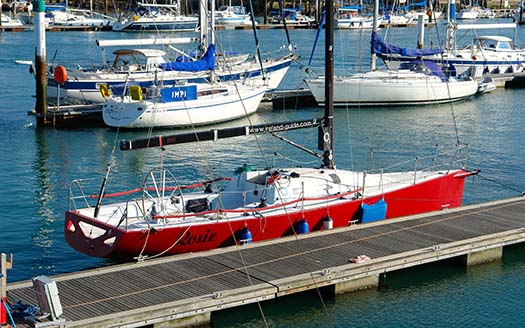
The Corby 36 Rosie was the last boat to be campaigned offshore by Roy Dickson in a remarkable career which has included several Fastnets and Round Ireland races in addition to success in Cork, on the Irish Sea, and in the Clyde. He now races the Corby 25 Rosie in club events. Photo: Brian Mathews
Each winter, the boats would be trailed back to a special spot beside Roy's house, and unless you were in constant attendance you'd no idea of just how much tweaking and surgery was taking place. He brings his brilliant engineer's brain to the challenges of boat performance enhancement, and many are the specialists who experienced that special thrill of anticipation when they got a Monday morning phone call from Roy which simply opened with the statement: "I've got an idea".
For as sure as God made little apples, an utterly fascinating project would follow, and even if it involved hours of brutal hard work by volunteers – such as the shifting of the weight configuration in the keel-bulb on Cracklin Rosie – well, Roy is the kind of leader who inspires people to loyal service way over and above the call of duty.
These days at age 83, Roy's sailing wings are slightly trimmed as he campaigns his Corby 25 Rosie in club events, but the mark he made in sailing inevitably makes you wonder if there's any modern equivalent to the innovations of Roy Dickson in his prime, and your only conclusion can be that the modern version would have to be a marine industry professional. And at the sharp end of Irish sailing development, there's no doubt that Chris Allen of Bray is the man to go to if you want thinking and work way outside the normal box.
Yet though he works with completely state-of-the-art composites, Chris is in the finest tradition of the invisible boat-builder. Bray may be a seaside town, but his workshop is well away from the harbour, in fact it's alongside a rather pleasant little residential development in the heart of Bray beside the River Dargle. But the workshop itself is a decidedly basic and utilitarian sort of place where the space is shared with a car restorer, and as the car-fixer works with a giant oven while Chris works with a small one in order to achieve the temperatures their composites require to cure, the fact that the shed was freezing – and that on a sunny April day – was neither here nor there.

Graeme Grant and Chris Allen, the hidden boat-builders of Bray. Photo: W M Nixon
Chris's current project – on which he's working with Graeme Grant, Irish boat–building's favourite Scotsman – is building the very latest in the International Moths, complete with foils and a proven speed potential for normally competent dinghy sailors of thirty knots, while the sky's the limit speed-wise if you're a true ace.
{youtube}QlAzBoXy6g8{/youtube}
They've the tiny hulls and decks ready to go, but are being held up on completion by the late arrival of special components from various manufacturers. Meanwhile, they're busy with refining ever further the moulding of the struts which support the whole crazy caboodle of trampoline and rig and daggerplate and rudder and foil control, which means they're utterly absorbed in the sort of time-consuming task which would give any formal company financial controller the heeby jeebies.

The carbon hull of a Chris Allen Moth is exceptionally light........Photo: W M Nixon

.....and we mean REALLY light. Photo: W M Nixon

Chris Allen with moulds for the ultra-light struts for the International Moth. Photo: W M Nixon
But then Chris Allen's career path is scarcely along orthodox lines. He started his sailing on Lough Muckno in northeast Monaghan where his father – Dun Laoghaire sailor Hugh Allen, who had crewed with Alf Delany in the two-handed Swallow Class in the 1948 Olympics – had been posted as the Bank Manager in Castleblaney. Hugh Allen wasn't going to let the little dark hills of Monaghan end his sailing, so he built a Mirror and founded the White Island Sailing Club to race on the local lake, as he rightly reckoned that a Lough Muckno Yacht Club wouldn't quite do the business.
Subsequently he was posted to Moville in Donegal, and by this time he'd moved up to GP 14s, so we could argue that the current pre-eminence of Moville in Irish GP 14 racing goes right back to a former Olympic sailor being in the town. And it goes further than that, as the Allens' GP 14 was subsequently sold to a rising star in Dundalk sailing, one Pat Murphy......
Meanwhile, like many another young fellow, Chris Allen gave up sailing for ten years from the age of 18. He was into the music business, which isn't a sports-friendly way of life. But by the age of 28, sailing had hauled him back in again by way of Bray Sailing Club, and he was soon bring technical expertise to boats. Somehow or other, he ended up in New Zealand, and while his musical abilities were useful, his primary occupation was working with the innovative boatbuilder Cookson's, whose many successful creations have included Ireland's 2007 Fastnet Race winner Chieftain (Ger O'Rourke), a canting keel Farr 50.
For high tech boatbuilders, a spell working with Cookson's is the equivalent of a Harvard MBA for anyone who wants to rise in the corporate executive officer ladder. But back in Ireland, the corporate world is slightly more developed than the marine industry, and in hoping to use his skills honed in New Zealand, Chris Allen found he was building the hugely successful Velvet Glove for Colm Barrington in a shed in Enniskerry, and then when he came to build the arguably even more successful Ker 32 Voodoo Chile for Eamonn Crosbie, he'd found his current hidden premises in Bray.
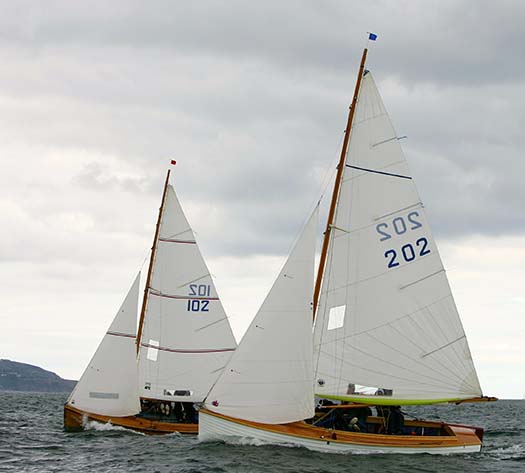
The glassfibre Mermaid Dolly (right) was a lovely piece of work by Chris Allen, but in the end the class decided to stay with timber construction.
His enthusiasm remains undimmed, as too does his readiness to express firmly-held opinions on boat-building of all kinds. But his skill in his specialist area is unrivalled, and he can be as versatile as any boatbuilder. Thus he was the man to go to in the days when the SB3 – then in its first incarnation as the SB20 – was experiencing a certain amount of teething problems. But equally, when Roger Bannon wanted to experiment with a GRP version of the Mermaid, he quite rightly reckoned that Chris Allen was the man to go to, and the result was one of the sweetest clinker GRP boats you'll ever see, even if the class in its wisdom decided eventually to stick doggedly with wood.
As we were in Bray, there'd been a hope of going on to see the two new Bray Droleens as they near completion, but in this case the invisible boat-building remained utterly invisible. The project is currently on hold while the workshop undergoes a renovation project, and the pair of little boats are temporarily in store in a shed whose key-keeper happened to be in the other end of County Wicklow. But nevertheless it's good to know that Anthony Finnegan and his team have continued the fine work started by the late Frank de Groot, and congratulations to Jim Horgan of Furbo on the south Galway coast, whose re-creation of a Droleen was recently awarded one of the Classic Boat Trophies in London.

Jim Horgan sailing his award-winning Bray Droleen in Connemara
It was far from the world of classic boats that the next item on our North Wicklow agenda lay, as we were working on the ancient Chinese principle that seeing something once is worth hearing about it a hundred times, and we were determined to see for ourselves if the new multi-functional maritime clubhouse really is being built beside the re-developed harbour and marina in Greystones.
So, having been immersed for the morning in the hidden marine industry, that afternoon we had the modern marine industry in its most visible form. For although the new clubhouse is as yet barely above ground, it is definitely being built. And nearby at the marina, James Kirwan and the team in BJ Marine were in hospitable form on a perfect sunny day with a steady stream of seriously interested visitors coming to see fully finished yachts in showroom condition. It was like a different planet, and we much enjoyed a conducted tour of a spanking new Oceanis 38 which has been prepared and laid out for a Dun Laoghaire owner who is quite clear in his own mind that he only intends to use the boat for day-sailing and hospitality purposes.
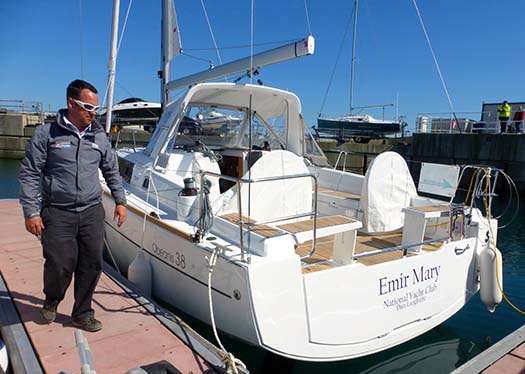
The way we live now.....James Kirwan of BJ Marine with a new ready-to-go Oceanis 38 in Greystones Marina. Photo: W M Nixon
Believe me, with the sun shining down and James Kirwan enthusing about the success of the new BJ Marine linkup to the Snowdonia Riviera on Tremadoc Bay with their latest office in Pwllheli in North Wales, you could be very easily seduced into availing of all the ready accessibility of today's front-line marine industry if you just happen to have the magic ingredient of enough money. But for most of us still spluttering our way out of the deluge which was the recession, it's a matter of making do as best we can.
And for others, the shiny new boats are not the way to go at all. On the contrary, they want to experience traditional hands-on lovingly crafted boat-building for personal fulfillment as much as having a boat at the end of it, and out the back of Clontarf Yacht & Boat Club there's a kind of Men's Shed operation convened by Ronan Melling which has been building a classic IDRA 14 for quite some time now, but the results show that they're willing to learn, and nothing is too much trouble to achieve perfection.

And now the tricky bit.....a spot of concentrated thinking under way last November as the Clontarf team grapple with the challenge of steaming and installing the frames in their new IDRA 14. Photo: W M Nixon
It's also the very essence of the invisible boat-building spirit, as they're only in action on specific nights for work spells of set duration. But on a first visit last November when you could already see that the planking work was of the highest quality, they'd got to the crucial stage of putting in the first steamed frame, which with all the hassle of keeping a steamer up to heat, is quite a step for an amateur team.
But they persevered despite having problems with several types of steam boxes, and then somebody had the wonderful idea for the Clontarf Contrivance. Somehow they made the leap from thinking how steaming a frame is a matter of keeping up pressure to the notion that a bicycle tyre is also a matter of keeping up pressure. The inner tube from a bicycle tyre, with a bit of another inner tube added for the required length, will neatly accommodate the complete frame for an IDRA 14. All you need to do is put the steam into it under the optimum amount of pressure. It has worked, for as the most recent photos show, the task so tentatively begun last November is now complete with as neat a framing jib as you could hope for.
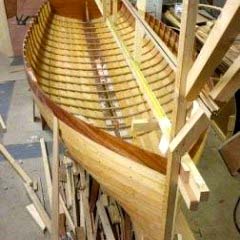
As neat a job as you could wish. The new IDRA 14 with the frames in place.

The secret weapon. We all know what a bicyle inner tube looks like, but have you ever thought of it as the Clontarf Contrivance for steaming frames for clinker-built boats?
The spirit of doing it for yourself is if anything even stronger along Ireland's western seaboard, and back in SailSat for the 29th March 2014 we featured – among many other boats – the Atkins schooner which the great Jarlath Cunnane was building for himself in Mayo in anticipation of the eventual sale of his Arctic Circle-girdling Northabout.
Well, Northabout has now been sold and will be going to the Antarctic as an expedition boat, but meanwhile last Autumn I grabbed a quick photo of the new schooner finally out of the building shed (which for once actually is a waterside shed), and we look forward to seeing her afloat and in action.

Shaping up nicely. Jarlath Cunnnane's new alloy-built schooner. Photo: W M Nixon
Far to the south along the Atlantic seaboard, and up the winding Ilen River above Baltimore you'll find Oldcourt and the Old Corn Store where the restoration of the Conor O'Brien ketch Ilen is moving steadily along. But as the Ilen project is ultimately Limerick based, the fine premises in Limerick where Gary MacMahon and his team built both the traditional gandelows and the CityOne dinghies provides an excellent workshop for building the more detailed parts of Ilen, and this week Gary circulated a photo of the deckhouse which will go above the engine room, and very well it looks too.

Ilen's new engine room deckhouse, workshop-built in Limerick. Photo: Gary MacMahon
For in winter, there is nothing more conducive to getting jobs completed than having adequate resources and a clean and comfortable workshop where you've a bit of space to go about the project, which so often is not the case for Ireland's hidden boat-builders.
But they do things differently in other places. Back in SailSat of February 7th this year, we ran a piece which included news about a restoration project which is under way with a specialist company in Palma in Mallorca, giving new life to the 37ft Fife-designed Belfast Lough One Design Tern of 1897 vintage. We published a photo of Tern as she was in July 2014, striped off and ready for the work. On Thursday, I received two photos of Tern being launched on Wednesday after nine months work. Just to show what has been achieved, we start with that photo of Tern in July 2014. Further comment is superfluous.

Tern as she was in July 2014.
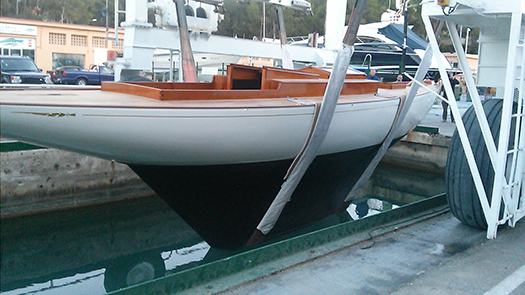
Tern as she was last Wednesday, test launching in Palma.

Work of the ultimate quality. Tern's new bronze deck fittings are probably worth more than the boat herself was when she was built to a fairly basic specification by John Hilditch of Carrickfergus in 1897.
Baltimore Harbour Landing Pontoon & Gangway to Aid Boating Visitors & Aquatic tourism
#baltimore – First pictures from Baltimore Sea Safari marine company show the West Cork village's smart new central pontoon and gangway being put in place in the inner harbour. The new Baltimore harbour facility will be beneficial as a landing place for visiting boats.
And it's sure to be useful to the Optimist dinghy class when 160 gather at Baltimore Sailing Club for the mid–term school break next week.
More on the sailing and boating wonders of West Cork in WM Nixon's blog here.
Wales Boat Show Moves to Pwllheli in 2015
#pwllheli – Wales' biggest boat show moves to Pwllheli in 2015 - Wales' deputy tourism minister welcomes news of show's return
A boating and watersports show will return to North Wales next year thanks to growing interest in the event, it was announced today.
The All Wales Boat Show 2015 will take place in Pwllheli as one of the first events at Plas Heli, the new Welsh National Sailing Academy and Events Centre.
It follows two highly successful years in Conwy where it gained considerable interest from the marine and tourism sectors and attracted thousands of visitors over several days.
Organisers believe the All Wales Boat Show plugs a hole in the market and helps highlight the huge potential in Wales, where the marine leisure industry still only accounts for 2.4% of the UK as a whole, according to the British Marine Federation (BMF).
Ken Skates, Deputy Minister for Culture, Sport and Tourism welcomed the news. He said: "Building on the previous successes of this event, I am delighted that Pwllheli will be hosting the 2015 All Wales Boat Show. It is a wonderful opportunity to showcase Plas Heli, the town's £8.3m sailing academy and events centre.
"The marine leisure industry in Wales is a major player in terms of economic development and the Welsh Government is determined to see the marine leisure industry grow and endeavour to ensure that coastal communities will benefit from this expanding market."
The 2015 All Wales Boat Show will take place from Friday May 8th to Sunday 10th May.
Davina Carey-Evans, Managing Director of Wales Watersports International which operates the All Wales Boat Show, said opportunities were now open for sponsors, exhibitors and supporters.
Those already onboard include marine specialists GJW Insurance, Royal Yachting Association (RYA) Wales/Cymru, and marine law experts Hill Dickinson.
Davina said the show was indebted to Conwy and Deganwy Quay marinas for establishing the spectacle as an annual event.
"We have enjoyed two great years in Conwy but such was the success of this year's event we simply need more space for 2015," she said.
"Pwllheli offers this but keeps the event in Wales, close to some of this country's best coastline and inland waters, and to local economies which this sector supports.
2015 will be a big year for Pwllheli and the Llyn Peninsula with the opening of Plas Heli, the new Welsh National Sailing Academy and Events Centre, which has received an £8.3 million investment from the European Regional Development Fund through the Welsh Government and Gwynedd Council.
Davina added: "Wales has a spectacular, scenic coastline of natural beauty with many safe anchorages, harbours and marinas. The capacity for growth is recognised and if nurtured sensitively will provide excellent potential to stimulate the economies of coastal communities.
"We believe the show can be a big success, and put down a real marker for the huge potential of the marine sector in Wales and the positive impact it can have on our economy as a whole."
The All Wales Boat Show is designed to appeal to local, regional and international visitors.
In 2014 thousands flocked to the three-day event at Conwy Quay marina, which featured luxury yachts through to power boats, coracles and even bath tubs.
Boats were on show from Fairline Wales, Hanse, Jeanneau, Beneteaeu, Robalo, Chapparal, Quicksilver, Sunseeker and Bayliner, plus over 100 used vessels. The first boat was sold within minutes of the event opening its doors to the public.
According to the BMF, the marine leisure sector supported 7,600 full time-equivalent jobs in Wales in 2013.
With events such as the All Wales Boat Show, developments such as Plas Heli and marina expansions, these numbers are set to increase.
In addition to the All Wales Boat Show website at www.allwalesboatshow.com a new site, www.waleswatersports.com has been launched by the show organisers to act as a major portal for the marine and watersports sector in Wales.
#classicboat – In the summer of 2014, the RNLI in Crosshaven received an unexpected cheque from an unusual source. As ever with lifeboat fund-raising, it was very welcome. But it's not every day you get €1500 out of the blue from a high fashion magazine like Vogue Netherlands. W M Nixon unravels the tale of how this came about, and ponders the various challenges facing the enthusiasts who try to keep classic boats in full sailing commission.
Once upon a time, on a pure early summer day of clear sunshine in Connemara, the demands of the day job caused us to head up the driveway of one of the pleasantest country house hotels in all Connacht. But the bright mood of the morning was soon dispelled by finding the place full of bad tempered if beautiful people from Italy.
It turned out they were the complete creative team – photographers, models, directors, editors and all – from a leading Milan fashion magazine. They were in Ireland for a long-planned and lengthy photo-shoot of the coming season's trendy tweeds. They'd reckoned the Irish climate would guarantee they'd be up to their ears in ideal conditions to provide moody shots of even moodier models in ultra-fashionable tweeds on an extraordinarily moody bog with unbelievably moody Irish mountains beyond, the whole thing recorded under an uber-moody grey Irish sky.
But for day after day, the sun had shone from a cloudless sky, the breezes blew only very gently from a blue Atlantic, the fabulous range of the Twelve Bens could quite reasonably have been re-named the Twelve Benigns, while the great swathes of bog glowed in friendliness in the sun. Moodiness was out. All was sweetness and light. And the forecast was for more to come.
So after another day of screaming frustration, they upped and left, screeching that they could find more suitable conditions back home, just down the road in the Valley of the Po. Doubtless they could. But back in Connemara everyone simply relaxed and enjoyed it, for the Italians' bill had been paid in full, they maybe could even re-let some of the rooms in the hotel in the few days remaining of the booking, and sure wasn't the weather just wonderful anyway, and had we ever seen the garden looking so well?
If you think fashion people are out on a limb in relation to the rest of us, take time to reflect that for most of humanity, boat people are odd too. Even with the newest craft, we still think of them as living beings, whereas the rest of the world thinks that, regardless of their age, they're no more than vehicles, and uncomfortable, awkward, dangerous and expensive vehicles at that.
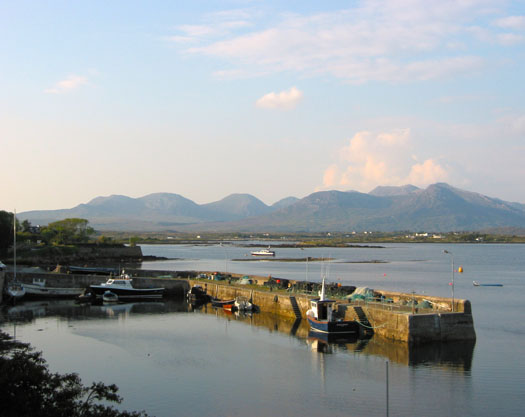
Roundstone in Connemara on a gentle day with a sublime view towards the Twelve Bens in the evening sunshine – totally unsuitable conditions for a mood-laden fashion shoot. Photo: W M Nixon
So when you get some sailing person whose pulse is quickened only by classic or traditional boats – anything unusual so long as it is full of character, and preferably old - then you get someone who scores a double negative with the ordinary run of boat-loathing humanity.
And though high fashion may be comprehensible to a larger proportion of mankind than is enthusiasm for old boats, nevertheless it too is still a rather peculiar or at least very specialist interest with which to dominate one's life.
Thus it's just possible that when high fashion and dedicated classic boat fans link up, an unexpected bond can be formed. Certainly it seems to have happened when Vogue Netherlands got together in Crosshaven during the summer for a photo-shoot with Darryl Hughes' superbly-restored 1937 Tyrrell-built 43ft ketch Maybird.
And the successful outcome of it all, with a useful cheque being presented to Crosshaven RNLI afterwards, was a reminder that while boat restoration projects can indeed be brought to a successful conclusion, once the job is done, you then have to move on to the next stage of finding imaginative and useful things for the boat to do, as there's nothing worse for the wellbeing of any boat than doing nothing.

After two good day's work afloat out of Crosshaven, a cheque for €1500 is handed over by Zoe Rosielle of Vogue Netherlands to Patsy Fegan, RNLI Deputy Launch Officer Crosshaven, with Shore Crewmember Robbie O'Riordan in support. Also in the picture are the rest of the Vogue Netherlands team, with three of Maybird's crew – Pat Barrett, Marie Keohane, and Darryl Hughes – top left, while fourth crewmember Joeleen Cronin took this photo
The story of Maybird has been told in snippets here before. She's a very near sister of the 16-ton ketch Aideen which was built by Jack Tyrrell of Arklow in 1934 for Billy Mooney, who in those days was Howth-based, but he later became a leading figure in Dun Laoghaire. Aideen was built to a Fred Shepherd design, but it's said that Shepherd had only been brought in to put manners on numerous very detailed drawings by Billy Mooney himself, including the layout – unusual at the time - of a centre cockpit.
Very conservatively rigged as a gaff ketch, Aideen was no slouch – she won her class in the 1947 Fastnet Race. Soon after, she was sold to Canada, where she was last heard of in 1974. Mooney claimed he'd to sell her because he could no longer afford to buy his crew dinner every time they won a race, and they were winning too often. That was a very Billy Mooney kind of remark, but certainly he almost immediately down-sized to the excellent little 6-ton John Kearney Bermudan yawl Evora of 1936 vintage, and with her he continued winning offshore until, with his retirement from work, he also swallowed the deep sea anchor and took up Dragon racing in Dublin Bay.
Meanwhile, during the mid 1930s an admirer of Aideen had been a keen sailing man originally from Cork, one W C W Hawkes, an officer in the Indian Army who commissioned Maybird, a near sister-ship of Aideen, from the Fred Shepherd-Jack Tyrrell team in 1937. Hawkes retired from India in the late 1930s to live in Restronguet on Falmouth Harbour in southwest England, but he was to have little enough use of Maybird with the intervention of World War II from 1939 to 1945, and his death in the late 1940s.

The first-born. Billy Mooney's Aideen was built by Tyrrell's of Arklow in 1934. Her younger sister Maybird, built in 1937, had a slightly longer canoe stern. Maybird's modern accommodation layout is also different, with the galley moved aft to the starboard side at the foot of the companionway
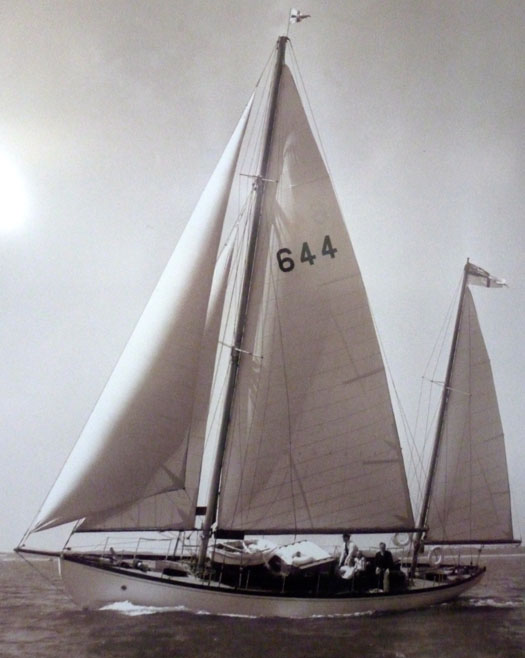
Maybird under her Bermudan rig in the late 1950s. Her restoration has included this rig's replacement by the original gaff configuration for the mainsail.
Subsequently, the 43ft ketch led a varied career, acquiring a Bermudan rig and an RORC rating for racing, and then in 1972 she was sailed out to New Zealand. Darryl Hughes came upon her there in 1990, and was smitten. Quite why some boats speak so eloquently to some people at certain times is sometimes difficult enough to understand, but the great project he has since completed with Maybird suggests that in this case it was the one very special boat for one very special person, and at just the right time.
He comes from a community in North Wales where there was no local tradition of industry or high-powered commerce, yet education at the local grammar school and a degree from Manchester University saw him moving into international companies, and by his thirties he was a rising star in general management in global organisations with a later emphasis on marine electronics.
This in turn fostered his interest in sailing, and he was learning the ropes with his own Nicholson 32 when a working spell in New Zealand led to his first sight of Maybird in the Bay of Islands. By 2007, with an early and well-funded retirement beckoning, he had her shipped back to England with a restoration in mind.
But the quotes he had for the job from established yards were horrendous, so he decided to do it himself as his own Project Manager. Sensibly, it was done in the heart of the English marine industry, where he could call on a diversity of talents to make progress with this project, which was soon well under way in Southampton in a temporary shed he'd created with tarps over a proper scaffolding structure.
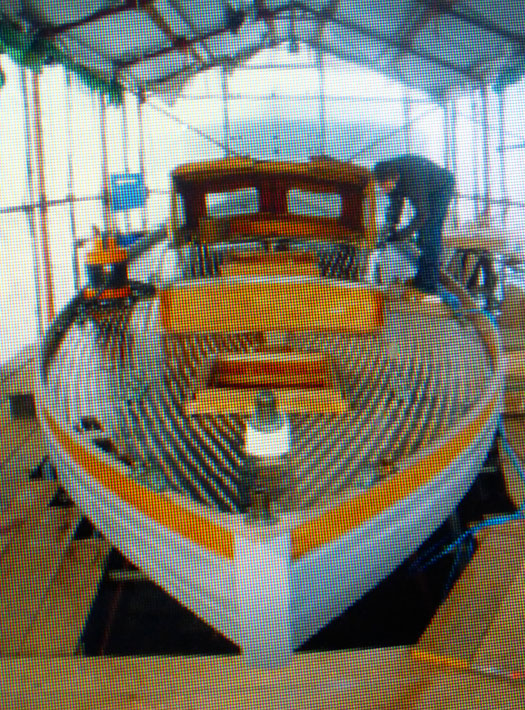
The owner-managed restoration project on Maybird under way in the temporary shed in Southampton. Photo: Darryl Hughes
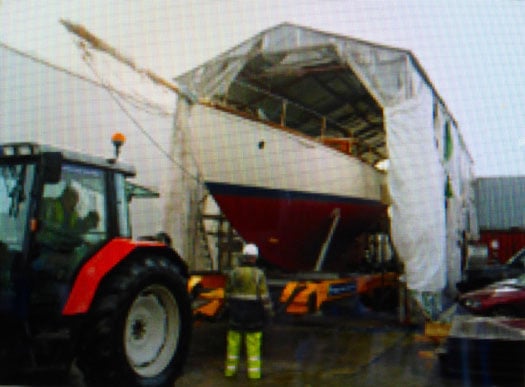
Mission accomplished – the restored Maybird emerges from the project workshop. Photo: Darryl Hughes
His long experience in international industry stood well to him, for the work went steadily ahead, and after two years the restored Maybird emerged as good as new, in fact better. And the project was completed for around a quarter of a million pounds sterling, about half of the most reasonable quote he'd received from the established yacht restoration yards.
For many people, such a restoration would be enough in itself, but Darryl Hughes showed his calibre by progressing on to keep Maybird as active as possible. She was raced in the classics in the 2011 Fastnet, and finished in a slightly better time than that recorded by Aideen in 1947. As well, she has been cruising extensively, sometimes on a semi-commercial charter basis, while also taking part in classic yacht regattas.
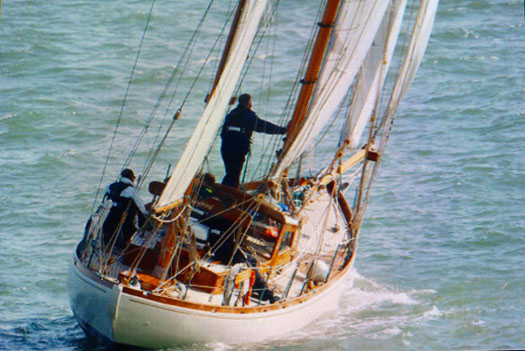
When it all becomes worthwhile. The restored Maybird sails again, re-rigged as a gaff ketch to the original design.......

.....and she turns in an encouraging performance, with a better time in the Fastnet Race of 2011 than Aideen had in the Fastnet of 1947.
An underlying theme has been his growing interest in Ireland and things Irish, thus he has based the boat for lengthy periods in Crosshaven while researching the history of the Hawkes family in Cork and in Cork Harbour sailing. But as well he has extensively cruised the Irish coast, and with his developing interest in literature he has twice taken a full part in the Yeats Summer School in Sligo in late July. The new pontoon just below the bridge in Sligo port might have been installed for Maybird's convenience, but Darryl Hughes is still the only person who is known to have sailed to the Yeats School as a matter of course.
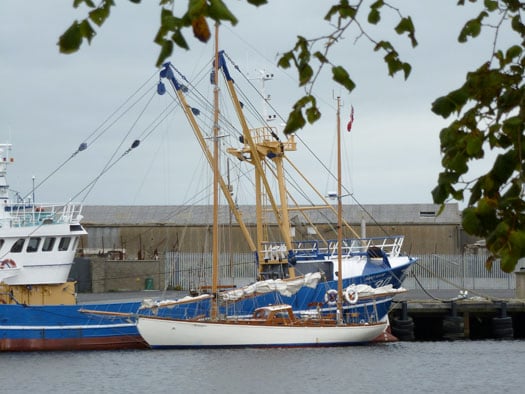
In 2011, Maybird returns to her birthplace of Arklow, where she was built in 1937. Photo: W M Nixon

Immaculate workmanship. The beautiful restoration of Maybird's deck and coachroof, seen in Arklow in 2011, contrasts with the rough and ready beer keg pressed into use to aid boarding. Photo: W M Nixon
Currently, Maybird is based in friendly Poolbeg Marina in Dublin Port, and her owner has spread his wings even further with a course of study in Trinity College, while living on the boat and pondering the production of the required 15,000-word dissertation on Irish writing. Last winter, however, was spent in the congenial surroundings of the Salve Marina in Crosshaven, and thanks to that there was the involvement with Vogue Netherlands – we let Darryl take up the story:
"Vogue Netherlands wanted to organise a fashion shoot in SW Ireland, and their location scout came across Maybird wintering at Crosshaven in Cork harbour back in February 2014. I agreed that they could use her as long as they made a contribution to the Crosshaven RNLI station, and the shoot took place in early June over two days.
The entire Vogue contingent consisted of eight people - three models, photographer, photographer's assistant, make-up/hair stylist, wardrobe assistant and overall fashion director, together with three huge suitcases of clothes for the models plus extra camera gear, lenses etc etc. To sail Maybird we had a crew of three plus myself, the other sailors being Pat Barrett, Marie Keohane, and Joeleen Cronin, the daughter of the house in Cronin's pub. As you can imagine, my major concern was the safety of all aboard as the majority were not sailors.
We met the day before onboard and worked out that Maybird's aft cabin would do as the changing area for the models and the huge suitcases were manhandled down the companionway and through the galley. The aft cabin was then transformed into a Vogue changing room/hairdresser's salon. The plethora of laptops, lenses and spare cameras plus the film banks – yes, film, not all that digital malarkey I'm pleased to say- were stowed in the saloon. The saloon became the studio, but we had access to all of Maybird's chart table and instruments if required. Fortunately, all of the chart-table electronics are duplicated in the doghouse, which also has the 15" plotter screen.
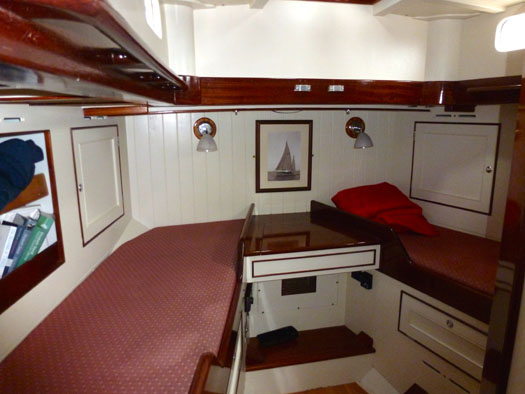
The aft cabin, luxurious by the standards of 1937, made for a rather cramped changing room/hairdressers salon during the Vogue Netherlands photoshoot. Photo: W M Nixon
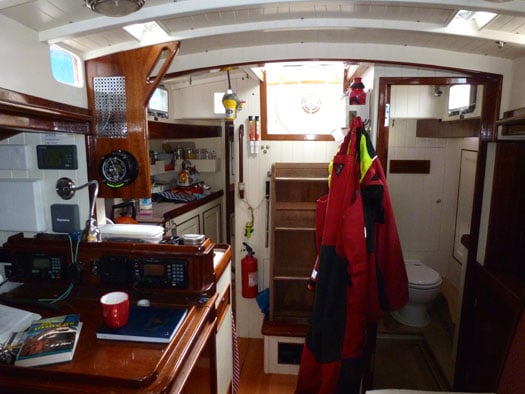
The galley and the chart-table together amidships at the foot of the companionway may seem a tight fit to modern sailors, but it would have seemed the height of comfort to cruising folk in the 1930s. Photo: W M Nixon
Once the stowage was sorted, we agreed that unless people were required on deck they stayed below. Everybody wore life-jackets and the only people that were allowed to take them off were the three models when the camera was rolling. Once the camera was silent the models donned their life-jackets again. We had a support RIB so that the cameraman could take pictures of Maybird sailing, so to an extent we had our own lifeboat with us, but my job was to keep all twelve "crew" on board.
We were blessed with gentle sailing conditions for the first day - wind max F3. The director wanted all Maybird's sails hoisted, and so we agreed set courses to sail. The crew set Maybird up, we chose courses that we could hold for as long a time as depth/traffic/hazards allowed, and then the photographer got to work with the models. We had an excellent rapport with the photographer, who understood that the skipper has the final say, and would stop shooting when we made the call "30 seconds to tack". Each of our legs or boards had to be agreed with the photographer in terms of where the sun was, the effect of shadows, background etc..
One of the models was starting to experience the early stages of sea-sickness as we approached the harbour entrance abeam of Roche's Point lighthouse, so we headed back inshore. Recovery was more or less instantaneous when back in flattish water.
Given the largely clement conditions we were out for some seven hours on the first day. But Day 2 was different. Wind was up to F5 gusting F6 and the sky overcast. The sea state was no longer smooth but more moderate to lumpy. I agreed with the director that we would go out, but we would not put up the mainsail - we would sail with jib, staysail and mizzen. I just wanted to keep things as simple as possible from a sail-handling viewpoint.
The cameraman wore his safety harness as well as his lifejacket as he was leaning over the bowsprit and over guardrails to take many of the shots that day, so I made sure he was clipped on. We agreed the models would not lean over the guardrails or do any poses that could lead to them falling off the boat. For this day, we were only on the water for some three hours.
Interestingly, the only pictures from Day 2 used were a black and white one with the female model standing on the foredeck. The sky really was nasty. No Photoshopping used there!
Despite Maybird's complexity in terms of numbers of sails and ropes, as she has a long keel she will sail on her own and hold her course when the sails are balanced so it was easy for her sailing crew to set her up and then crouch down out of the cameras way whilst the models did their stuff.
Both the photographer and his assistant were sailors back in the Netherlands, so that helped a great deal. The Maybird crew of four for one day, three on the other, really kept an eagle eye on the Vogue crew in terms of safety - that was the challenge, not sailing the boat. We tacked rather than gybed and as I say, when the wind did pick up, we sailed without the main - one of the great advantages of the ketch rig.
We managed to stay out of trouble, so our only dealings with the Crosshaven RNLI was to hand over a cheque to them".
That was only part of the good work done by Maybird in 2014. She was signed on to play a key role in an Irish Coastguard exercise in Dungarvan Bay later in the summer. Then once again the skipper's participation in the Yeats Summer School in Sligo resulted in a round Ireland cruise, with bits of Scotland thrown into the mix. And now she's a study centre in Dublin, helping to absorb the multi-facetted culture of our unique city. Truly, a busy ship is a happy ship.
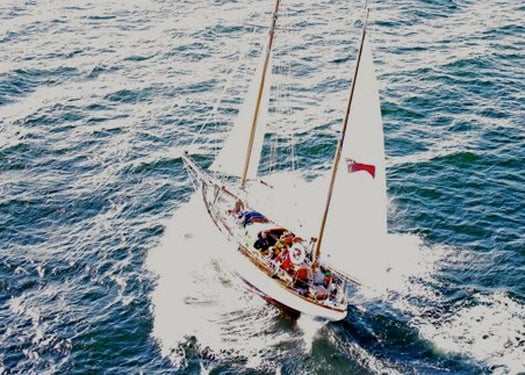
Maybird as seen from the S&R helicopter during an exercise in Dungarvan Bay. Photo courtesy Irish Coastguard.
Are you Towing your Boat with the Correct Driving Licence?
#towing – Laws about towing boats and trailers in Ireland has been considered a bit of a grey area by some sailors who hope for the best every time they hitch up but now the Road Safety Authority has announced that a person who held a full driving licence for a car before 13 November 1989 and who did not then avail of the car and trailer licence option may now do so.
A car licence allows you tow up to 750kgs but if you tow a bigger weight without the correct licence you could be driving uninsured.
To establish whether a driver is entitled to apply for the car and trailer licence the Road Safety Authority (RSA) must be satisfied that the driver held the car licence before 13 November 1989 and this initial assessment is being carried out by the RSA. You must have been born before 13 November 1972 and have held a full driving licence for a car before 13 November 1989 in order to apply.
A person who believes that s/he is now entitled to the car and trailer licence should now take the following steps-
Complete an Initial Assessment Form.
Once completed, you can return the form to the Road Safety Authority, Ballina, Co. Mayo.
The RSA will carry out its assessment and advise you of the outcome. If the initial assessment is positive you must then formally apply for the licence. Any person who wishes to be considered must complete the Initial Assessment Form here and return it to the RSA by Friday 8 November 2013.
Boatyard Bliss, Where Owners Can Work On Their Craft
#boatyards – The interface between sea and land is infinite in its variety, and attractive to modern man as somewhere interesting to live. So if you set up a little coastal boatyard almost anywhere, very soon you'll be told that the property would be much more valuable if it was re-developed for residential use. Thus in Dublin, while we're more than happy to go along with the ancient north-south Liffey divide (Vikings to the north, Normans to the south, and the Irish somewhere out in Kildare), the reality is that in terms of property values, the divide is east-west, though admittedly with added north-south undertones.
This is fine and dandy for real estate theorists and the happy owners of desirable property near the coast. But with layup time and winterising schedules upon us, it makes life increasingly difficult for the dwindling band of boat owners who try to do their own boat maintenance and modification, and may even have built their boat from scratch in the first place, or at least from a bare hull.
Such people – and I'm one of them – operate in a different world. We amateurs working on boats, we barely qualify as a genuine economic activity. Our wives (very few of whom get directly involved) quite rightly dismiss it all as foostering. As for the rest of the community, we amateur bodgers are an embarrassment. We're out of sync with the new reality. These days, we live in an increasingly specialised society, where the preferred location for boat-building is in a purpose-built factory many miles inland where the land is cheaper, while waterfront servicing and repairs are swiftly executed in state-of-the-art units, where throughput has to be rapid and efficient.
Delays are anathema to people running these successful waterfront businesses. But delays and leisurely contemplation are essential for the DIY boat bodger, as he may eventually think of a much better way of coping with a problem which would have been dismissed as intractable by the professional, whose solution would have been the complete replacement of the troublesome item, and probably the complete replacement of the entire boat, all done before close of business that day.
The boat bodger doesn't think in terms of days, let alone close of business. All he needs is all the time in the world, and his own little space. In most modern coastal communities, neither is available. So we wax nostalgic about traditional yards where the boats came up a slip (at least a day's work in itself), and the work schedule stretched gently into the infinite beyond.
Every so often we still come across such places, and if we're on other business in the area, I am expressly forbidden from going near these paradises for boat nuts, as they're very heaven, and I'd be lost for the rest of the day But you won't find any in Dublin, where boat life now is all travel hoists and cranes and strictly scheduled throughput, while people think a slip is something that happens on a banana skin. However, if you get way from the big urban centres, there's more chance of finding yards which somehow retain enough of the traditional mood to relax the stressed boat owner, while at the same time embracing enough of the present to stay in business. And they're filled with boats which are themselves a living history of yacht design.
Perhaps the most remarkable boatyard place in Ireland is around Oldcourt in West Cork, where the Ilen River comes conveniently near the road as it meanders on its way down from Skibbereen to Baltimore. Several marine-related businesses seem to overlap here, there are boats of all shapes and sizes, and there are certainly some craft for which this is the final port of call. But as Spring arrives, somehow the numbers ashore get less, the number of emptied cradles increases, and despite the unhurried atmosphere, a lot gets done.
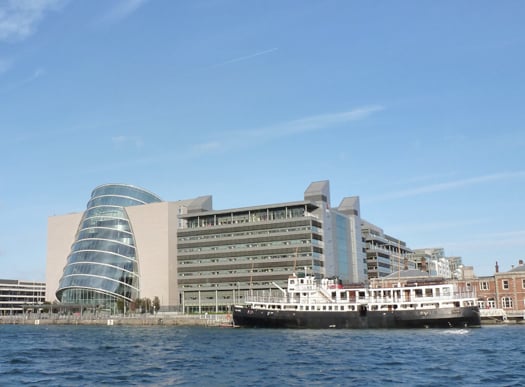
Oldcourt achievement. The Cill Airne restaurant ship in Dublin was successfully converted for her new function at Oldcourt on the River Ilen in West Cork. Photo: W M Nixon
A remarkable Oldcourt achievement was the conversion of the Cill Airne, the restaurant ship now berthed in the heart of Dublin. Originally, she was Cork Harbour's tender to take passengers out from Cobh to great liners, and then she was a training ship for the marine academy. Her active seagoing career finished, she still had plenty of life in her for a new existence as a restaurant boat, but a conversion job in an orthodox dockyard would have been prohibitively expensive. Somehow they managed to get her up the river and alongside at Oldcourt, and once there, were able to take their time for a very fine job. In all, 132 different tradesmen, recruited mostly in West Cork, worked on the Cill Airne in the Ilen River. This past summer, when she was the focal point for the Riverfest during the Old Gaffers Golden Jubilee visit to Dublin, the boat-bodging gaffers were completely charmed to learn that this fine conversion had been done at an old-fashioned boatyard, just like the kind of place they dream of locating their own boats, if only they could find it in their area.
The heart and soul of Oldcourt, the warm spirit of the place, is embodied by the continuing restoration of the Ilen, the Conor O'Brien ketch which Gary MacMahon brought home from the Falklands quite a few years ago now. Her gentle restoration is an end in itself, and a balm for the soul. Love of wood is inherent in most of us, as an affinity for wood and an instinct to do something useful with it was a key survival mechanism at an important stage of human evolution. So it is still part of our makeup, and the Ilen restoration shed is a place of healing and mental comfort.
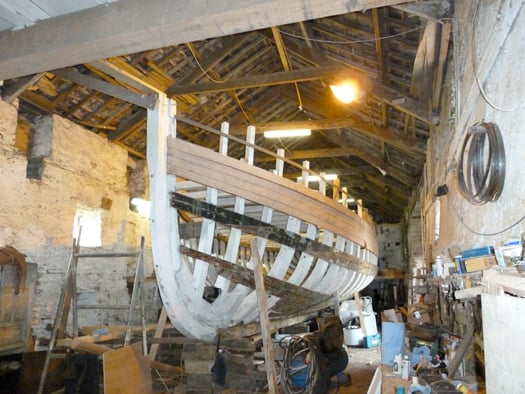
Sweet work. The restoration of Ilen has been a reassuring feature of life in Oldcourt for some time. Photo: W M Nixon

An early stage of the Ilen's restoration. Photo: W M Nixon
Up in the northeast of Ireland, hidden away behind the islands along the west side of Strangford Lough, is Billy Smyth's boatyard at Whiterock. If you were a film producer and requested your location scouts to find the classic traditional small boatyard to make a movie about sailing in times past, they would become ecstatic about Billy Smyth's. It's very basic yet remarkably efficient, while the quality of the work done by Kenny Smyth and his team is first class. And inevitably, there's the usual small quota of boats whose owners don't seem to want them launched now and again, and some from one year to the next. For some time, I'd been trying to trace a John B Kearney-designed 1936-built 6-ton yawl, the Rosalind, which had last been reported in the Poole area in the south of England many years ago. She'd gone under the radar, but she turned up this past summer in Billy Smyth's, where she has been under a cover for years in a corner of the yard, her owner's intention unfathomable.

Just another boat under a cover in the corner of a boatyard...Photo: W M Nixon

....but as the cover was hauled back......Photo: W M Nixon
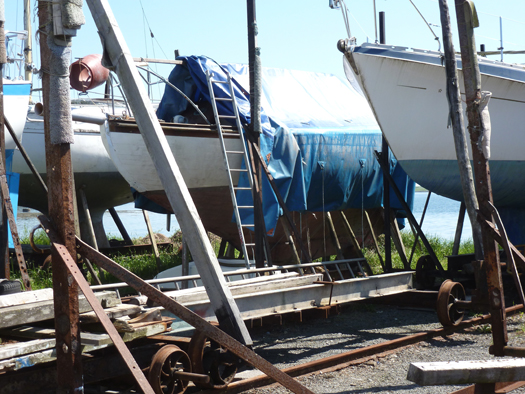
.....the 1936 John B Kearney 6-tonner Rosalind was revealed. Photo: W M Nixon
You may well think that it's only in Ireland that you can still find these gems of living boatyard history, but in the summer we were at the head of the Helford River in Cornwall, and found ourselves in the midst of the easygoing maritime mayhem which is Gweek.
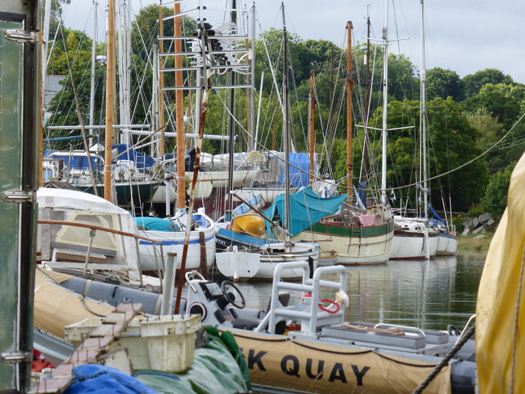
At the head of the Helford River estuary in Cornwall, Gweek Quay is a place of promise and fascination. Photo W M Nixon.

Gweek is renowned as the birthplace of several Luke Powell pilot cutters. This is the Agnes, built in 2002 and based on a Scillonian pilot cutter of 1841. Photo: W M Nixon
In recent years, Gweek has been best known as the place where Luke Powell built his renowned Pilot Cutters, whose lines are unchanged from the mid-19th Century. But there's much more to Gweek than that. If your perception of England is of an over-regulated place where nothing much can happen without some peak-capped official's say-so, Gweek is an eye opener. Basically it's a creekhead boatyard, where the yard is filled with an astonishing variety of craft, many of them character boats, and some of which haven't been launched for a very long time.

Serious work. GRP gigs emerge from the moulding shop at Gweek. Photo: W M Nixon
There's an unmistakable air of amiable anarchy, yet with underlying purpose. Some sheds were busy while we were there, finishing GRP double-ended gigs. Nearby was a large pop-up tent of a boatshed, and a looksee inside revealed it held the famous classic offshore yawl Lutine, restored recently at Gweek and taking a season off from seafaring. And all around another part of the creek, there were the houseboats.
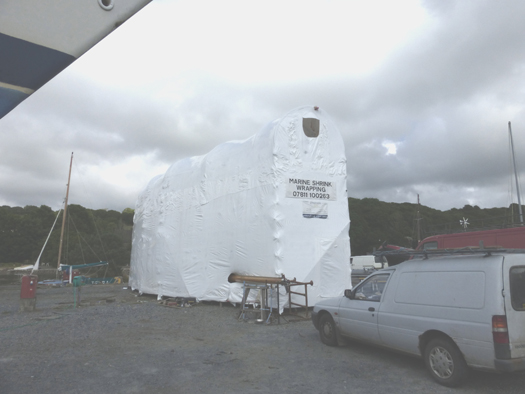
A pop-up boatshed invited a look inside.....Photo: W M Nixon
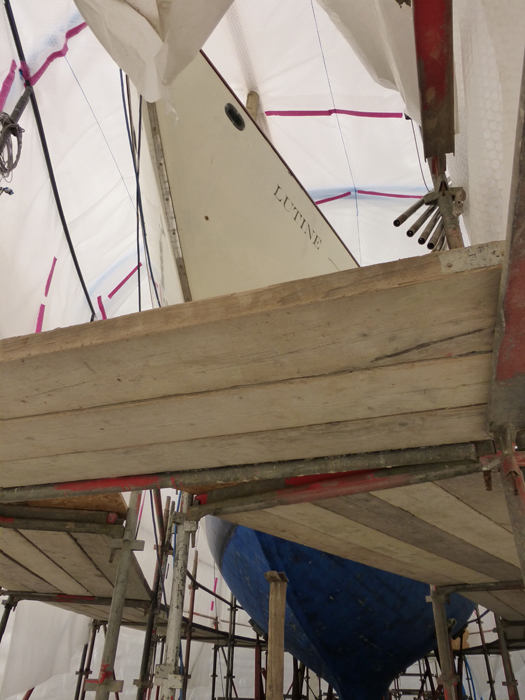
...and we weren't disappointed. It was the classic offshore racing yawl Lutine. Photo: W M Nixon
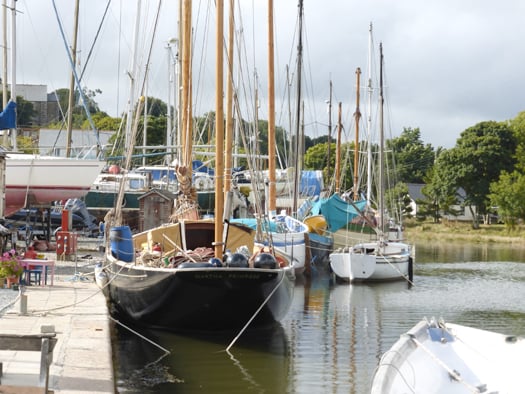
At Gweek, classic yachts share space with more humble craft....Photo: W M Nixon

....and the owners are determined to have domestic comfort while in port. Photo: W M Nixon
Clearly, the houseboats, both in their location and appearance, are subject to no planning requirements whatever. Ancient hulls had their upperworks extended in stratospheric style. What looked like a former River Thames lighter in beside the trees had a three storey structure atop it like a Missisippi riverboat. And yet they weren't the last resort of people desperate for somewhere to live. Judging by the cars parked about the place, living in houseboats – however odd - was a lifestyle choice made by people who could well afford to live ashore.

The houseboats in Gweek are a study in themselves. Note the "office & facilities block" on right, complete with public phone Photo: W M Nixon

With no apparent planning restrictions, the Gweek houseboats can go for height........Photo: W M Nixon
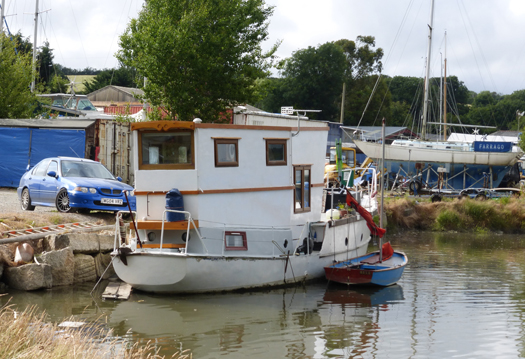
....even on boats where you wouldn't expect it. Photo: W M Nixon
So it's all of a piece that for some glorious years, the yard in Gweek was where Luke Powell built his cutters. They're arguably of an even older design type than the Galway Hookers, yet like the Connemara boats, they attract a passionate following, people who would sail on no other boats, and in a contemporary anchorage, a Powell cutter will certainly stand out, a glorious blast from the past.
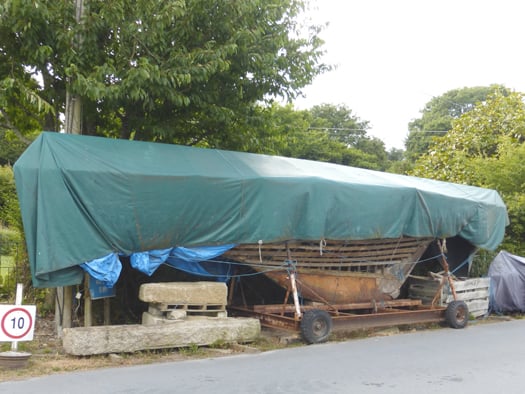
Not all Gweek projects are showing signs of progress. This may have been an International 6 Metre once upon a time, but she needs a lot of attention. Photo: W M Nixon
Blasts from the past were the theme of another boatyard visit, this time to Gloucester where the Severn winds its way between the Malvern and Cotswold hills. If you follow the doings of the tall ships, you'll know that T. Nielsen & Co's yard at Gloucester is the place to get sailing ship problems put right, and the yard in the midst of the historic docks in Gloucester has deservedly acquired a high reputation for serious work.
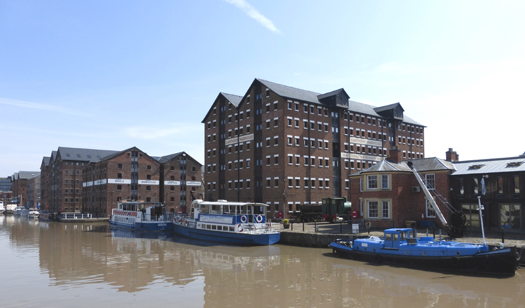
Gloucester's historic docks provide a home for the Nielsen company, specializing in work on tall ships. Photo: W M Nixon
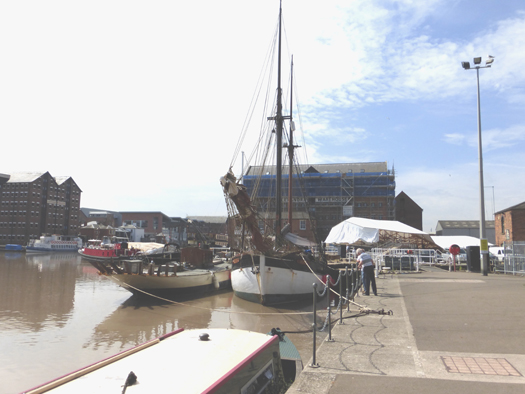
There's always something of interest in the Nielsen corner in Gloucester, in this case a Victorian yacht awaiting restoration beside a Baltic ketch, while in the foreground is a narrowboat from the English canals. Photo: W M Nixon
This is big boy's territory – you get an appreciation of the scale of the Nielsen operation by realizing that one of the smallest craft they've worked on in Gloucester recently was the 52ft 1911-built Bristol Channel Pilot cutter Hirta, which had a complete re-build to emerge as new, and under her original name of Cornubia. A long time ago, Hirta was owned by Tom Cunliffe, who bought her in Scotland in 1982 and called into Howth on his way south at the beginning of a very productive partnership which included a Transatlantic cruise by the northern route. But pilot cutters, like Galway Hookers, weren't built of materials which were expected to last for ever, so it's good news that the Cornubia had this re-build completed in 2010, and is now based at Plymouth under the ownership of the Bristol Channel Pilot Cutter Trust.
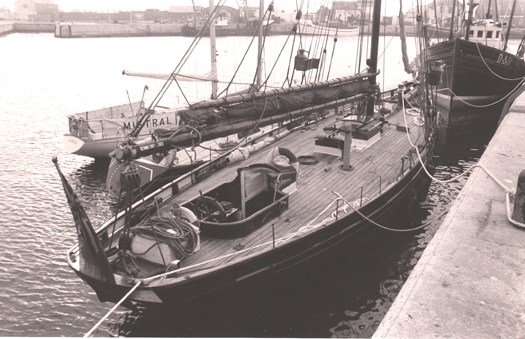
The 52ft pilot cutter Hirta in Howth in 1982. She has recently been re-built in Gloucester, and now sails under her original name of Cornubia. Photo: W M Nixon
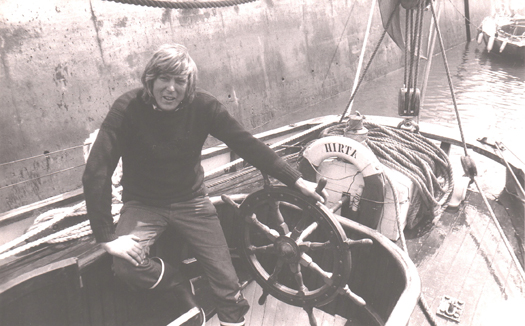
Tom Cunliffe, distinguished maritime writer and former President of the Old Gaffers Association, aboard Hirta in Howth in 1982. Photo: W M Nixon
The Nielsen people were in more familiar size territory when they did the lofting and made the rig for the Jeanie Johnston, and when we were there, they were busy with a major restoration on the Kaskelot, the three-masted 153ft Danish-built barque which was in one of the two dry docks, while other interesting craft at various stages of work were afloat in the dock.
Gloucester is where the heart of the country interacts with the sea, but in order to reach it from the Bristol Channel, vessels have to transit the long ship canal along the Severn valley up from Sharpness, which means that when you reach Gloucester, there's no question of people being impatient to nip out for a day sail – this is a place for working at seagoing ships. Yet Gloucester is also a port on England's myriad of inland waterways, in fact for a period it was an unrivalled entrepot for waterborne trade. But the historic docks are so perfect in their completeness that you get the feeling the burghers of Gloucester must have been on the very cusp of finishing this state-of-the-art waterways centre just as the railways were beginning to make such places redundant, and subsequent generations must have been tempted to flatten the impressive warehouses and fill in the basin.
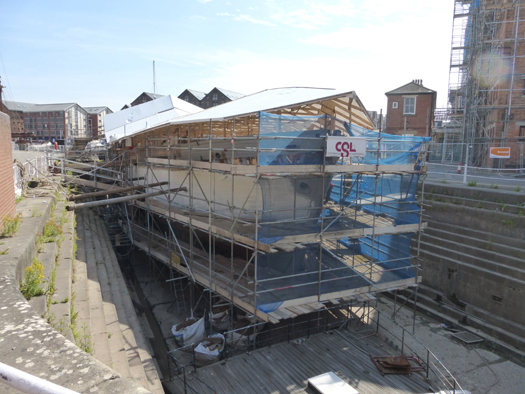
The three-masted barque Kaskelot undergoing major work in one of the Gloucester dry docks. Photo: W M Nixon
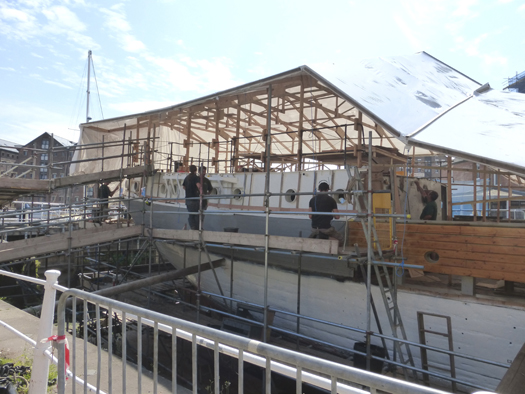
Even on a Saturday morning, there's plenty of work going on for tourists to watch.....Photo: W M Nixon

.....and there's a helpful information board to give you the dimensions of the ship in the dry dock.......Photo: W M Nixon
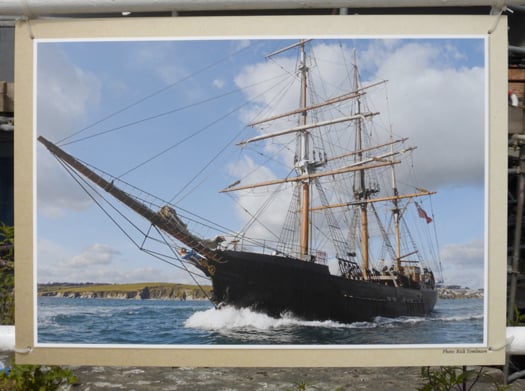
....and there's even a photo to show you what she'll look like when the job is finished. Photo: W M Nixon
But miraculously Gloucester docks have survived, and not least of the elements in their current regeneration is the interest and energy of the Nielsen yard. We were there on a Saturday morning, yet they were busy on the Kaskelot. I didn't dare ask if it was a stipulation of their contract for having the use of the quayside and the dry docks, that they should continue working through the weekend when visitors are about. No doubt about it, the public loves work – they could watch it all day. And what used to be demanding and sometimes dangerous work is now a matter of recreational viewing. Who knows, but some time in the distant future, the government of Bangladesh may think it sensible to pay grants to the families who currently break up ships by hand on the shore of the Indian Ocean, in order to encourage them to continue their lethal but fascinating work for the edification of tourists.
Buying a Boat? Here's a Checklist Before Choosing Your New Craft
#BOATS FOR SALE – It's definitely that time of year again when thoughts turn to getting on the water. If you're buying a boat for the first time, it's probably because you've spent a bit of time on one and like the whole idea. One thing we can guarantee: being on the water is great fun, but it's more than that – it's a way of life. If you take to it, you will begin to see the the world from a different perspective and your leisure time will take on a whole new meaning.
Find a boat that Suits You and Your Pocket
The first and most important consideration is that the boat you buy matches your lifestyle, so you need to know what you want on the water.
So, establish what it is that you most want to do with your boat: the size, how far – or how near – you want to travel, how many people you want to accommodate, what sports events you plan to enter, and whether you'll be inland or offshore.
"A good dealer will ask these questions of a prospective client, and find out exactly what it is they expect from their time on the water," says Tadhg Foley of Marine Action Boats in Tipperary. "Forcing an unsuitable boat onto a client will just backfire on the dealer, as they won't come back for their second – or third – boat, so it's best to be definite about your requirements so the dealer can match boat with buyer. Do you want to ski? Are you going fishing? All these things make a big difference in the type of craft you'll need."
Martin Salmon of MGM Boats says it's important that the buyer gets good value from his boat, in that they get to use it often and well. "We'll often include tuition in a boat-buyer's package," he says, "or make sure that there's an engineer and skipper on board when a new boat owner takes delivery – a 'comprehensive handover', because the more the boat is used, the better."
"If a prospective client has been referred to us by an existing client, we'll often show them a selection of craft and suggest they discuss it with the experienced sailor who referred them to us in the first place," says Hugh Mockler of HM Yachts in Crosshaven. "If they're reluctant to join a sailing school, individual tuition on the new boat can easily be arranged, and joining a club is an excellent way to get into the 'time on the water' way of life. With an active social side and maybe the odd cruise-in-company with like-minded companions, the new boater will soon see the benefits", says Hugh.
Brand New or Pre-Owned
Budget is a big consideration, of course, but there are other factors that will affect whether you buy a new or pre-owned boat.
New boats may suit those who are planning to keep their craft for some time, have been on the water before and know exactly what they want.
However, a five-year-old model could be as much as half the price of a new one, giving you a whole lot more boat for your money. Even a year-old boat will have depreciated by between 20-25% since it left the 'showroom'. There's also the possibility that any snags will be have been ironed out by the previous owner, particularly if they're a careful boater. Martin Salmon of MGM says if you're worred about depreciation, then "buying a used boat can be a good investment if you choose carefully. They don't depreciate as much from the purchase price."
As for the type of boat to buy, the choice is very wide – there are over 40 types out there, and one of them will fit you. Again, it's very much dependant on what you want from your water-based experience. See our 'What's on Offer' guide to boat types and uses.
Brokerage or Private Sale?
As with any big purchase, if you're buying a new boat it's recommended you either buy direct from the manufacturing boatyard or from one of their officially-appointed dealers. Any boat advertised as new that does not appear to originate from either of these sources should be checked out carefully with the boat builder.
There are several routes to buying used boats: from a dealer who has boats in stock as part-exchange; from a broker who sells the boat on behalf of the owner; or from the owners themselves, in a private sale.
Donal McClement of Crosshaven Boatyard in Cork recommends the use of a reputable broker for advice. "The vendor pays the broker's fees, not the buyer, and you have the advantage of the years of experience a broker can bring to the transaction. It's well worth it."
All the necessary paperwork and checks should be in place when buying from dealers and brokers, and their reputation and future business success depends on making their clients happy.
The majority of private sellers are genuine. However, there's a possibility that you're being offered a boat for sale that's stolen, or there's a fraudulent transaction going on. This is the risk taken when not buying from an established business. However, there are precautions you can take to protect yourself and your boating future.
Set the Conditions Before You View
It's a good idea to decide before viewing any boat that you will not buy the first boat you see, or even on the same day you see it. The initial viewing should be part one of a sequence of events to ensure the boat you fancy is really the one for you.
The first view – If it's a new boat, your first visit will be to look over the boat and others in the same range, probably. You'll want to find out about optional extras, colours, delivery lead times, warranty, part exchange (if applicable) and payment terms, as well as price.
A used boat should be checked out for condition; identify any rectification, repairs or improvement work that might need to be done, confirm the asking price and payment terms, and decide if, having examined the boat, you want a sea trial.
The sea trial – If you can take the boat out the first day you see it, so much the better. If not, arrange another time for a sea trial – you have to know how the boat handles on the water.
If it's a power boat, it's good if the engine is cold and not already warmed up when you're taking it out. It could be that it's difficult to start or it may smoke a lot from cold, and with an already-warm engine it's impossible to tell.
Check the boat's steering and handling capabilities at slow speeds, in confined situations. If it's a sea-going boat, see how much it rolls and pitches, taking waves of different sizes at alternative angles; and if it's a planing boat, check how quickly and easily it gets on the plane. Make a mental note of the sea conditions – a boat's performance is relative to the sea condition in which it's operating.
If it's a sailing boat, try different points of sail, sailing into and away from the wind and check the boat's manoeuvrability, stability and performance of the sails and rigging under load. And also check how the boat performs on the engine. At the end of the sea trial, re-examine the bilges, engine compartment and the boat generally for any evidence of oil or water leaks.
Remember also to check used boats for title, charges and theft. "The single most important thing you need, if your boat is a post-1985 model, is proof of payment of VAT," says Donal McClement. "If VAT is paid in one member state, it is considered paid in all member states." Proof of VAT payment can take the form of the original invoice or VAT receipt: "It's unlikely that people would have the VAT receipt, though, as it would come from the original dealer," says Donal. "However, liability rests with the buyer if no proof of payment is provided."
With a used boat there are some checks and information gathering that you should carry out. These checks concern EU RCD compliance, validation of Hull Indentification Number (HIN) number, Declaration of Conformity, the aforementioned evidence of VAT compliance and searches for finance outstanding.
Again, according to Donal at Crosshaven, the CE plate/stamp on the boat is vitally important, so make sure it's there.
When you've seen evidence of build and VAT compliance, and have all of the information that you need to carry out your basic security checks, you should take some time to 'think about it' and get these checks done.
Assuming the boat passes your essential security checks, and that this boat is definitely the one for you, arrange for a professional surveyor to examine the boat. Use a reputable surveyor.
Cutting the Middleman
Bernard Gallagher of Dublin's BJ Marine believes purchasers get the best value from their local dealer: "Most Irish boatyards are dealing direct with the manufacturer, so there's no middle man." Gallagher says the larger manufacturers are offering very good value to their dealers; "We've never bought better, so we can pass on those savings to our customers." He also says it's never been easier to check the value of boats, with access to the internet and boating publications.
So, before entering into negotiations with a seller, you need to decide what price you're prepared to offer and at what price you're prepared to settle.
With a new boat, it's quite rare to pay the brochure price. What you may be offered as a discount depends on many factors such as availability, demand, and model age – it's all down to timing and negotiation.
With used boats, it's less straightforward. The simplest way is to compare the boat you're interested in with other boats for sale of the same make and model. But be sure you're comparing like with like. Age, condition and specification make a difference as well as the ancillary equipment that's included in the sale, so make allowances for any differences in these.
Negotiating A Deal
New boats – Timing is important when buying a new boat. Special deals are often available during boat shows, towards the financial year-end of the boat builder or dealer, and when a model is due to be superseded by an updated version. So do all your research, be aware of model cycles, decide what you want to buy and then try to negotiate at the best time.
If discounts aren't on offer or are lower than you would wish, you might do better to negotiate the inclusion of ancillary equipment in the price; items such as ropes, fenders, lifejackets, GPS, depth sounders, chart plotters and even deck cushions, a CD system or a cooler bag. The value to you is higher than it costs the dealer to supply these items, so having some of them 'thrown in' can be a good compromise.
Used boats – With used boats, the selling price might represent great value as it is, but then again it might not: only your research will tell you which way round it is.
However, any combination of the following should help you to persuade the seller that there is room for negotiation:
• Ancillary equipment that is missing, in poor condition, not working, out of date or not included in the sale;
• Faults and rectification work required and identified by you or your boat surveyor;
• Lack of documentation such as:
– Original sales invoice and evidence of VAT compliance
– Builders certificate and CE declaration of conformity
– Boat manual
– Service history
– Current safety certificate on a canal boat
– VHF radio licence (if applicable). Note: Donal McClement of Crosshaven Boatyard reminded us that the VHF radio licence stays with the craft, "it used to stay with the owner, but now belongs to the boat."
Financing Your Boat
When buying through a dealer or broker, expect to be asked for a deposit, which may be non-refundable if you back out of the transaction. So be sure that you want to buy and have the funds available before you commit.
If you require finance, dealer and brokers may be able to introduce you to alternative sources of borrowing (for which they may receive a commission, so bear this in mind when negotiating).
MGM waiver their commission in lots of cases, according to Salmon. "In the current fiscal climate where finance companies are looking at every detail, it's more important to have the client get finance for the boat they want."
With a marine mortgage, you can normally obtain up to 80% of the purchase price secured against your boat. Before granting a marine mortgage the finance house will require a full, out-of-water survey and valuation on boats other than brand new boats. The lender will also check that there is no finance outstanding on a new boat.
Dealing with a private individual is slightly more complex. They are not professional sellers and will not necessarily know how to formalise the transaction to help protect not only themselves but you as well. So it is as much in your interests as theirs to ensure all potential purchasing disasters are avoided.
What's out there?
Inland Boats
Canal and narrowboats – Usually built of steel, the hulls can last a lifetime if minded. Ideal for pottering peacefully about the canals and less tidal rivers at about 4mph, for days or even weeks at a time. These boats are low maintenance, very economic on fuel and often include most home comforts.
River boats – Usually built of GRP and lighter than their steel counterparts, they're more powerful than narrowboats so can be used comfortably in tidal rivers as well as the odd excursion out to sea in calm conditions. They are, however, more expensive to operate and maintain.
Sea-going boats
Bowriders, cuddy boats, dinghies, dorys and ribs – All different types of day boats that are the ultimate in flexibility whether it's usage, power, speed, manoeuvrability or access to land, coves and beaches. They can be comfortable in calm and slight seas as well as a pleasure to cruise at the appropriate speed up rivers. These boats can usually be trailed and so can be towed to different locations throughout the country, as well as abroad, providing access to a multitude of sea, lake and river locations.
Speedboats, sports boats and sport fishers – These are high-powered, high-speed boats, great at riding the waves out at sea and delivering the thrills and spills of watersports, whether it's waterskiing, wakeboarding, keeping up with the fish or simply the excitement of speed.
Motor boats and motor sailors – These are the motor boats that are built more for the sea than the river, and are typically the boats you'd find moored in marinas around the coast. Generally, they fall into three categories:
Planing Boats are designed to rise up and ride on top of the water, ideally operating at a high speed. They are perfect for transporting people from marina to marina and to stay overnight on, whether it's along the coast of Ireland or over to the UK, the Channel Islands or maybe even to France. They're also great for day use to find those calm bays from which to anchor off by a quiet beach or lunch and a swim, or maybe a visit on land, using a small on-board dinghy.
Displacement Boats are designed to glide through the water at slow speeds, moving the water out of the way, pushing it sideways and down. They are very stable and comfortable in moderate or rough seas. Built for overnight and sometimes 'live-aboard' use, whether in a marina, ashore, or on a buoy, these boats are ideal for those who wish to travel distances economically and have plenty of time to get there.
Semi-displacement boats fall between the planing and displacement boats. They're comfortable, stable, with less tendency to roll than the steel displacement boats, the semi-displacement is intended to give you the best of both worlds – higher top speed with comfort at the lower speed. Having a smaller draft, this type of boat is often designed for river use as well as for offshore.
Sailing Yachts – These boats obtain their power from the wind with the use of sails and normally have a small engine to navigate rivers (for use if 'sailing' is restricted or not allowed) or manoeuvre in harbours and marinas. There are many types of sailing boat but what they have in common is that they provide a comfortable, peaceful yet exhilarating experience on the water that is also comparatively economic.
However, sailing requires you to understand and deal with many of the elements – wind, tide, prevailing currents – and means you must plan your journeys carefully to ensure that you don't get caught out by the weather and tidal gates, not to mention navigation skills, or a lack of them.
However, for those who want to be at one with the sea and have the time to acquire the skills needed to get out in a sailboat, there's nothing more wonderful.
Putting your boat up for sale
Clean it, start it and check it
There are lots of boats for sale and probably quite a few like yours on the market at the same time you want to sell yours, so if you want to sell your boat more quickly than the rest, then it needs to stand out from others. That requires effort and a little investment.
Your boat needs to be clean. For example, the hull, the superstructure, the decks, rails, windows, carpets, curtains, galley surfaces, toilet, bilges, engine compartment, fenders, canvas covers and sails need to look as clean and tidy as possible while it is up for sale.
Check in particular that the engine(s) start easily from cold, as well as from warm, that rigging and sails operate smoothly, and that the navigation lights work, as should the horn, bilge pumps, internal lights, winches, heating, gas appliances, generator, cooking facilities, taps, and toilets.
Check the engine oil and water levels, and check for worn hoses, connectors and fuel lines that would be better replaced. Also, if there is any ancillary equipment that you plan not to include in the sale of your boat, remove it, at least when the boat is being viewed. Within reason, replace or refurbish anything that simply won't clean up, is badly worn, or is not working.
Paperwork you need to sell
To obtain top price for your boat, you should ensure that all your boat documents are in order.
Documents of compliance If your boat was manufactured after June 16th 1998 you should have a 'Declaration of Conformity', stating that your boat complies with the EU Recreational Craft Directive. If you've lost this piece of paper, there should be the boat builder's CE plate inside your boat; the original manufacturer will be shown on the plate and you can contact them for a duplicate declaration.
The more service and maintenance records that you possess, the more you can justify a top price for your boat.
Additionally you should have your boat's original sales invoice which shows that the VAT on your boat was accounted for. Once more, if you have lost this, contact the boat builder. If they didn't sell the boat directly themselves, they should know who did. When you know who sold the boat originally, you can contact them for a copy of the original sales invoice.
Assessing what it's worth
To decide what price at which to sell your boat, do what the buyers do – research the current market. This means looking through magazines like Afloat and noting what prices are being asked by brokers and dealers – and private advertisers – for your type of boat. Remember that your boat may well be worth more than those you've seen advertised, depending on several factors including specification and condition.
Once you've carried out your assessment, then you can decide at what price to advertise.
If you sell through a broker, they'll be able to advise you. If you're selling privately, you should aim to set your price just below that advertised by brokers for an identical boat, leaving you room for negotiation, to end up with a satisfactory price. However, if you want to sell it quickly, then you may have to think again. It's up to you.
Go for broker?
When selling your boat, you do have a choice: to let a professional do it for you by using a dealer or independent broker, or whether to handle the sale yourself. There are benefits and drawbacks to both – and the decision can only be made by you.
Choosing a broker or dealer
The benefit of using either a dealer or a broker is that they make the job of selling your boat comparatively easy and worry-free for you. They'll manage the sale from beginning to end.
They'll deal with the advertising, sea or river trials, liaise with surveyors, rectification work contractors employed on your behalf, assist with negotiations and deal with all the paperwork. And, in some cases, they'll even berth or store your boat in their yard free of charge, to enhance their display of boats for sale and make it easier to show potential buyers your boat.
But this comes at a cost. You can expect to pay a sales commission of between 6% and 10% of your boat's selling price, plus VAT. The percentage charged principally depends upon your boat's value; the lower the boat value, the higher the percentage charged.
Additionally, you may incur charges for storage, cleaning, maintenance, a contribution towards advertising, sea or river trials as well as underwrite surveyor and rectification costs. All of this, together with the sales commission percentage, needs to be negotiated and agreed to in writing with the broker or dealer concerned.
Selling your Boat Privately
If you choose to sell your boat privately, you'll get the benefit of saving the costs of a dealer or broker, but you'll need to get organised.
If you've followed this guide so far, you'll already have assembled the paperwork that will not only enhance the value of your boat but makes it easier to sell.
Your Advertising Campaign
Now you need to plan your advertising campaign. Check local press to see what your options are and how much they cost. Afloat, for instance, would include your ad on their website as well as their printed magazine, so it's not just paper advertising but high-profile internet promotion.
Decide what size of ad and what duration you wish. It's a good idea to take some good quality photographs of your boat and, in the text of your advert, include all of those items that will help set your boat apart from the rest, justify your sales price and attract potential buyers. Don't forget to include full details of your boat's description and specification.
Also ensure to include full contact details and make sure they're correct. If possible, supply both daytime and evening contact numbers, mobile and landline, as well as an email address if possible.
Dealing with Enquiries
Make a list of potential dates and times that buyers can view and test your boat so that when the telephone rings, you have all of that information to hand and can deal with the enquiry professionally.
Negotiating the Sale
The secret to sales negotiation is to be well prepared.
If you've followed the steps contained in this guide, you will already know how a potential buyer is going to try to dive the price down. So work out either how you plan to counter this or by how much – if anything – you're prepared to adjust your price for any items that may be spotted by a potential buyer.
Also, think abut whether there is anything that you can 'trade' with, that has less of a value to you than money off the selling price. This may satisfy the buyer's need to obtain a discount and at the same time be acceptable to you.
With boats, the first offer you receive can often be the best offer, so think carefully before turning down an offer that falls just short of your asking price or the price that you were originally prepared to accept. It may be some while before you receive another.
Cash is King
Unfortunately, cheques or banker's drafts are no longer totally secure methods of receiving payment.
With a banker's draft, you should ensure that your bank has honoured the draft before signing the boat over to the buyer, as payment is no longer guaranteed. This method helps protect you legally in the event of a cheque or draft not being honoured. To ensure that a cheque is going to be honoured, ask your bank for an express clearance. A charge will likely apply for this service.
Also, do not accept a cheque for an amount more than your asking price! Some sellers have actually accepted a cheque made payable to a third party for more than their asking price and then issued 'change' for the difference – and been surprised that they lost both boat and money.
Even cash could be counterfeit – unlikely, but possible – so when accepting cash as settlement, it'll be for you to make the judgment as to the trustworthiness of your purchaser.
Minimizing Your Risk
To reduce the chance of losing boat and/or money, always get the full name, address, telephone number/s and email address of a prospective buyer, and check them out as best you can before agreeing to anything. For instance, find a reason to send an email that needs a reply, and yet another reason to telephone the prospect and check how the telephone is answered.
If the purchaser lives near you, carry out a 'drive by' to see if the car that they drove to come view your boat is the one in the driveway. And if they're buying your boat 'blind' – that is, they've never been to view your boat – alarm bells should be ringing loudly. Have you ever bought a boat blind? Would you ever? If you wouldn't, why should they? Exactly.
New Yachts and Motorboats Added to Afloat's Boats for Sale Site
#BOATS FOR SALE – A 1995 Nauticat 32 that the broker says is 'a really good example of this quality pilot-house cruising yacht', a 1984 Jeanneau Arcadia 29 designed by Tony Castro, a 2005 Beneteau First 36.7 with a rig replacement and a Princess 415 motorboat that 'must be sold' have been added to the Afloat Boats for sale site over the last 24 hours. Check out over 286 boats for sale here
Lakeside Marina is Venue for First Powerboat Run of 2012
#POWERBOAT – Lakeside Marina on the river Shannon is the venue for first power boat event of the season and if it's a chilly one there's a good chance the event will end in Sean's Bar for a 'warmer upper'. That's according to organiser Cormac Smith who intends to run the first Powerboat run of the year 201 on February 11th at Lakeside Marina in Athlone.
The aim is to launch boats at 10.45am but plans will be very dependent on weather and size/ type of boats that turn up. All welcome. The schedule is as follows:
Meeting @ Lakeside Marina From 10.30
Launch ing from 10.45
Run up or down the lake (weather dependent)
Lunch In Lecarrow or Hodson Bay Hotel
Return trip on Lake
Recover Boats 4.30-5.00 ish




























